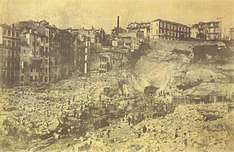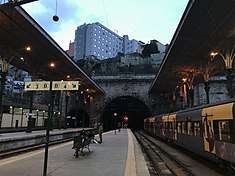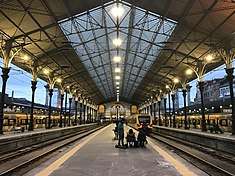São Bento railway station
| São Bento Railway Station (Estação Ferroviária de São Bento) | |
| São Bento Station | |
| Railway Station (Estação Ferroviária) | |
The main facade of the São Bento Railway Station | |
| Official name: Estação Ferroviária de São Bento/Estação de São Bento | |
| Named for: Convent São Bento de Avé Maria | |
| Country | |
|---|---|
| Region | Norte |
| Subregion | Greater Porto |
| District | Porto |
| Municipality | Porto |
| Location | Cedofeita, Santo Ildefonso, Sé, Miragaia, São Nicolau e Vitória |
| - coordinates | 41°8′44″N 8°36′37.2″W / 41.14556°N 8.610333°WCoordinates: 41°8′44″N 8°36′37.2″W / 41.14556°N 8.610333°W |
| Architects | José Marques da Silva, Juan Pina, F2IS |
| Styles | French, Beaux-Arts |
| Materials | Ceramic, Wood, Stone, Azulejo, Iron |
| Initiated | 1864 |
| Owner | Portuguese Republic |
| For public | Public |
| Easiest access | Praça de Almeida Garrett, Rua do Loureiro e Rua da Madeira |
| Management | Instituto Gestão do Patrimonio Arquitectónico e Arqueológico |
| Status | Property of Public Interest Imóvel de Interesse Público |
| Listing | Decree 67/97, Diário da Repúblic, Série-1B, 301 (31 December 1997); Incluído in the Historic Centre of the City of Porto (PT011312140163) and the Historic Zone of the City of Porto (PT011312070086) |
| Wikimedia Commons: Porto São Bento Railway Station | |
The São Bento Railway Station (Portuguese: Estação Ferroviária de São Bento) is a 20th-century railway station in the civil parish of Cedofeita, Santo Ildefonso, Sé, Miragaia, São Nicolau e Vitória, in the municipality of Porto, district of Porto.
History
.jpg)

As early as 1864, the Guia Histórico do Viajante do Porto e Arredores (Historic Guide for the Traveller to Porto and Surroundings) implied the intention to construct a central station to be located in the Palacette of the Quinta do Cirne (Campo 24 de Agosto).[1]
In 1887, José Maria Ferreira and António Júlio Machado, alderman, presented to the municipal council a project for a Central Station in Porto, elaborated by Hippolyte de Bare.[1] The following year, Emídio Navarro, Minister of Public Works, authorised the construction a railway line between Campanhã and a central station to be built near Praça de D. Pedro.[1]
It was finally decided to build the station on the site of the Benedictine Convent of São Bento da Avé Maria, which had been ordered built by King Manuel I of Portugal in 1518.[1] The monastery was burnt in a fire in 1783 and later rebuilt, but it was in a state of great disrepair at the end of the 19th century.[1]
The project was entrusted to Porto architect José Marques da Silva, who designed a building under the influence of French Beaux-Arts architecture.[1]
In 1890, work on the tunnel proceeded and lasted until its conclusion in 1893.[1] The first train arrived at the station in São Bento in 1896, where Marques da Silva presented his final design for the central station railway in Porto.[1] But, in 1897, there was a landslide at the opening of the tunnel on the southern edge of the station. The work on the northern part of the station was finished.[1] By the following year, the tunnel was completed.
Work on constructing a station along the angle of Praça Almeida Garret and Rua da Madeira began in 1900. The cornerstone was placed by King D. Carlos I.[1] In 1901, the administrative commission for the railway, authorised the work on the station, which was expanded to also act as a postal station.[1] The project was approved in 1903, and its construction started the following year.[1] A metal awning was built over the platforms to protect commerce.[1] The tiles of the atrium were made in the Sacavém factory.[1] The station was inaugurated on October 5, 1916.[1]
In September 1988, a dispatch authorised the beginning of a process to heritage list the property.[1] First steps to renovate the site began in 1992, with work on the facades, recuperation of the boxes and ceiling, that included work on the station and exterior illumination.[1]
In October 2016, Porto Vivo-Sociedade de Reabilitação Urbana ordered that public work in constructing a hostel on the lateral facade of the station should be stopped until an official application for a license was obtained.[1] The company responsible for the installation was F2IS - Consultadora e Gestão de Projectos, which finally submitted an application on 17 October.[1]
Architecture
.jpg)
.jpg)
.jpg)
The station is located in the historic centre, occupying a large space delimited by the Praça Almeida Garrett, Rua da Madeira and Rua do Loureiro, as well as the escarpment of Batalha, where a tunnel has been carved into the hill.[1]
The symmetrical, three-story, granite building has a "U"-shaped plan, with its principal facade oriented to the southwest. A building of geometric rigor, it has a central corp corresponding to the principal atrium and on either extreme two volume.[1] The central body has strong architrave cornice over corbels, with dense repetitive rhythm that covers the whole building.[1] Rounding the facade, is a robust frame with similar fenestrations, while the lateral facades maintain a relation between span symmetry, content and decoration.[1]
The vestibule is framed by pilasters, covered in azulejo tile.[1] Near the ceiling, is a blue and gold frieze decorated with stylized flowers, while below them is another polychromatic frieze, evocative of the history of the road in Portugal.[1] Below the friezes are large azulejo "paintings" representing historical events in Portuguese history.[1] The azulejo are integrated into the architecture by frames in granite which decorate the lines of the atrium.[1]
Vestibule and historic tile images
There are approximately 20,000 azulejo tiles, dating from 1905–1916, that were composed by Jorge Colaço, an important painter of azulejo of the time.[1] The first tiles were placed on 13 August 1905.[1] To the left of the entrance is a scene depicting the Battle of Arcos de Valdevez and Egas Moniz before Alfonso VII of Castile, while to the right, is D. João I in Oporto, with his fiancé and the Conquest of Ceuta. On the border wall at the entrance are small panels depicting countryside scenes.[1]
The upper parts of the frieze are lined with polychromatic azulejos depicting a chronology of some forms of transport used by man in Portugal.[1] The lower and upper frame of the frieze consists of a line of tile in blue, browns and yellow in a stylized geometric pattern.[1]
Under this, on the top of the north wall, is a large composition that covers the entire wall, depicting the Battle of Valdevez (1140), with two groups of antagonists and other knights in the background.[1] This monochromatic composition is executed in blue on white tile, similar to all the other main azulejo "paintings".[1]
Below it is another composition that represents meeting between the knight Egas Moniz and Alfonso VII of León in Toledo (12th century), offering his life, his wife and his sons during the siege of Guimarães.[1] In the south, is a painting of the entrance to Porto of King John I and Philippa of Lancaster, on horseback, to celebrate their wedding (1387).[1] Below that is the Conquest of Ceuta (1415), with the principal figure of Infante D. Henrique who subjugated the Moors.[1]
The wall into the station is divided into multiple compositions.[1] To the left, a vision of the procession of Nossa Senhora dos Remédios in Lamego, an exhaustive description and detail showing the multitudes within an urban setting.[1] Under this composition are two panels that represent her "promise" on her knees and, the other, her actions at the "miraculous" fountain.[1] In the same detail is the pilgrimage of São Trocato to Guimarães over andor and carriage.
The lower panels show a picture of a cattle fair and pilgrim camp.[1] The central panels of the wall represent four work scenes: the vineyards, the harvest, the wine shipment down the Douro and work in the watermill.[1] On the pilasters separating the vains with access to the street, below the polychromatic frieze, is a series of smaller compositions.[1] Above these are medallions depicting romantic scenes and, below, allegories associated with the railway referencing time and signalling, in an expression of contemporary Art Deco.[1]
Services


São Bento is the main terminus of Porto's suburban railways lines and western terminus for the scenic Douro line between Porto and Pocinho. The station also serves the Minho, Braga, Guimarães, Caíde/ Marco de Canaveses and Aveiro lines.[2] All trains leaving São Bento call at Campanhã as their next station.
The station is near vintage tram line 22 and is connected to São Bento Metro Station on Metro line D.
References
Notes
- 1 2 3 4 5 6 7 8 9 10 11 12 13 14 15 16 17 18 19 20 21 22 23 24 25 26 27 28 29 30 31 32 33 34 35 36 37 38 39 40 41 42 43 44 Sereno, Isabel; Santos, João (1994), SIPA, ed., [http:/www.monumentos.pt/Site/APP_PagesUser/SIPA.aspx?id=5559 Estação Ferroviária de São Bento/Estação de São Bento (IPA.00005559/PT011312140090)] Check
|url=value (help) (in Portuguese), Lisbon, Portugal: SIPA – Sistema de Informação para o Património Arquitectónico, retrieved 15 April 2017 - ↑ Comboios de Portugal, Porto São Bento, accessed 24 August 2018
Sources
- Carvalho, Manuel (1986), História da Arte em Portugal (in Portuguese), 11, Lisbon, Portugal
- Carvalho, Patrícia (16 October 2016), "SRU diz que mandou parar obra de hostel em S. Bento, promotor nega", Público (in Portuguese), Porto, Portugal
- Meco, José (1989), O azulejo em Portugal (in Portuguese), Lisbon, Portugal: Editorial Presença
- Quaresma, Maria Clementina de Carvalho (1995), Inventário Artístico de Portugal. Cidade do Porto (in Portuguese), Lisbon, Portugal
- "Uma Estação que não era do Estado", Jornal de Notícias (in Portuguese), 13 May 1996